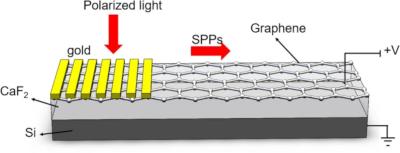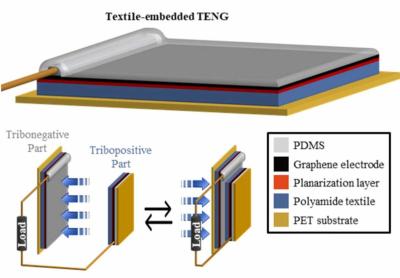Graphene sensors: introduction and market status - Page 5
Researchers design semitransparent image sensors for eye-tracking applications using graphene and QDs
A team of researchers from The Barcelona Institute of Science and Technology (ICFO) and Barcelona-based startup Qurv Technologies have designed flexible, nearly transparent graphene-enhanced image sensors that could be hidden in plain sight.
The sensors, based on graphene and quantum dots, could be integrated directly onto eyeglasses or curved windshields, placed right in front of a user’s eyes. This could make eye-tracking hardware less bulky, improve the accuracy of gaze detection, and reduce computational complexity, says Frank Koppens, who co-led the research and co-founded Qurv in 2020.
Lyten raises $200 million in series B equity round
Lyten has announced it has raised $200 million as part of its over-subscribed Series B funding round, to scale manufacturing and commercialize its first three product lines: Lithium-Sulfur batteries, lightweight composites, and next generation IoT sensors.
The round is led by Prime Movers Lab, a venture capital firm focused on investments in breakthrough scientific startups and has $1.2B in assets under management. Prime Movers Lab is joined with significant participation from strategic investors and sector leaders Stellantis (previously announced), FedEx Corporation, Honeywell, and Walbridge Aldinger Company. Additional strategic, venture capital and individual investors make up the remainder of the round.
Researchers design scalable graphene sensor array for real-time toxins monitoring in flowing water
A team of researchers, led by the University of Wisconsin-Milwaukee, recently developed a path to mass-manufacture high-performance graphene sensors that can detect heavy metals and bacteria in flowing tap water. This advance could bring down the cost of such sensors to just US $1 each, allowing people to test their drinking water for toxins at home.
The sensors have to be extraordinarily sensitive to catch the minute concentrations of toxins that can cause harm. For example, the U.S. Food and Drug Administration states that bottled water must have a lead concentration of no more than 5 parts per billion. Today, detecting parts-per-billion or even parts-per-trillion concentrations of heavy metals, bacteria, and other toxins is only possible by analyzing water samples in the laboratory, says Junhong Chen, a professor of molecular engineering at the University of Chicago and the lead water strategist at Argonne National Laboratory. But his group has developed a sensor with a graphene field-effect transistor (FET) that can detect toxins at those low levels within seconds.
The Graphene Flagship details its achievements in graphene automotive technology
The Graphene Flagship, Europe's $1 billion graphene research initiative, has summed up its progress in advancing graphene-based innovations for automotive in the last ten years. The project examines, among other topics, how graphene can address key challenges in the automotive sector, such as fuel efficiency, recycling, and environmental impact.
Graphene has the potential to drive significant advancements in the automotive industry — from strengthening structural components to improving electrochemical energy storage (i.e., Batteries) efficiency and safety in electric cars as well as enhancing the performance of the self-driving car. The Graphene Flagship has orchestrated a number of projects researching the benefits of graphene in automotive applications and how vehicles can be improved. The Graphene Flagship reports it is now seeing this research and development come to fruition. Listed below are the automotive-related advancements that were achieved.
Researchers design rGO-based nerve gas sensor using human scent receptors
Researchers from Seoul National University and Samsung Electronics have developed a sensitive and selective nerve gas sensor using human scent receptors. It reliably detected a substitute for deadly sarin gas in simulated tests.
Nerve gases are often very potent, requiring highly sensitive sensors to detect them quickly and accurately. One method of boosting sensitivity combines human scent receptors with nanomaterials such as reduced graphene oxide to create a "bioelectronic nose." But since these nerve gases are still highly dangerous even in laboratory settings, many scientists rely on safer, substitute molecules instead. In the case of the sarin or soman nerve agents, dimethyl methylphosphonate (DMMP) is a common replacement. Previously, the receptor protein hOR2T7 has been used to detect DMMP, but it could only do so when the nerve agent substitute was in a liquid form, rather than as a gas. So, the research team wanted to design a "nose" of their own that was both highly sensitive and selective for the gaseous form, using nanodiscs containing the hOR2T7 receptor.
Researchers use graphene foam to create triboelectric nanogenerators for energy systems and autonomous sensors
Researchers from the University of the West of Scotland (UWS), in collaboration with Integrated Graphene, have examined the potential of three-dimensional graphene (3DG) foam (Gii) as an active layer in triboelectric nanogenerators (TENGs) and as an energy harvesting power source for autonomous sensors.
The research showed that the force of a human footprint on a pressure-sensitive mat equipped with Gii-TENG sensors can produce enough energy to anonymously keep track of people entering or leaving a room.
Researchers achieve multiomics biosignal detection in real-time via an electronic biosensor
Scientists at DARPA, Siemens, US ARMY, Georgia Tech Research Institute, and Paragraf - through recently acquired Cardea Bio, now Paragraf San Diego - presented novel multiomics capabilities, by detection of both protein and RNA biosignals simultaneously on a single graphene-based biosensor.
Dr. Kiana Aran, Chief Innovation Officer at Paragraf San Diego, stated: “Having a single technology platform that can detect both protein and DNA/RNA biosignal analytes at the same time on a small-scale detection device, is a major technological advancement. While it initially will impact when and where we can detect viral infections, with time it will also work for other types of diseases. This will enable new, better, and way faster diagnoses for any types of diseases or biothreats.”
Researchers use graphene transistors to design novel biomimetic sensing system
Researchers from Shanghai Jiao Tong University, Chinese Academy of Fishery Sciences, BOKU-University of Natural Resources and Life Sciences, University of Oslo and Oslo University Hospital, MIT, 2bind and Avalon GloboCare have designed a novel sensor that could detect the same molecules that naturally occurring cell receptors can identify.
The researchers created a prototype sensor that can detect an immune molecule called CXCL12, down to tens or hundreds of parts per billion. This is an important first step towards developing a system that could be used to perform routine screens for hard-to-diagnose cancers or metastatic tumors, or as a highly biomimetic electronic “nose,” the researchers say.
Researchers use graphene to design a multi-parameter tunable plasmon modulator
Researchers from Ningbo University and Southeast University have designed a hybrid silicon-dielectric-graphene-grating structure, which can modulate the amplitude, wavelength and phase of surface plasmon polaritons (SPPs) simultaneously.
The SPPs are stimulated by the grating and propagating on the graphene, the Fermi level of the graphene is controlled by the voltage applied between silicon substrate and graphene. This structure has potential applications in fields like optical switches, communications and photo-detection.
Researchers use printed graphene electrodes for textile-embedded triboelectric nanogenerators for biomechanical sensing
Researchers from Portugal's Instituto de Engenharia de Sistemas e Computadores – Microsistemas e Nanotecnologias (INESC MN), Universidade de Lisboa and the UK's University of Exeter have developed an efficient flexible triboelectric textile by using printed graphene electrodes with polydimethylsiloxane (PDMS) and the textile itself as the triboelectric pair.
To achieve this, the team used a textile planarization technique with a polyurethane adhesive, along with three different deposition methods: graphene droplet films (GDF), graphene immersion films (GIF), and graphene spray films (GSF).
Pagination
- Previous page
- Page 5
- Next page




